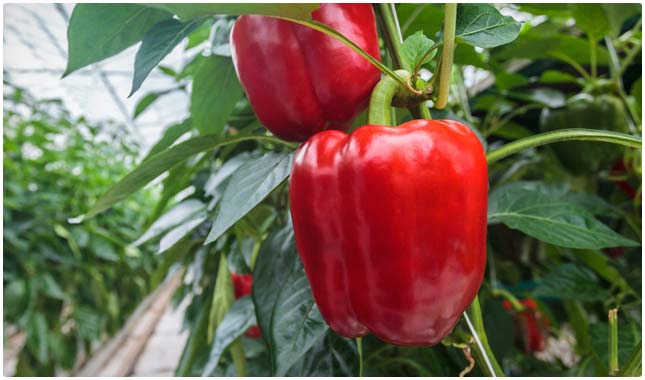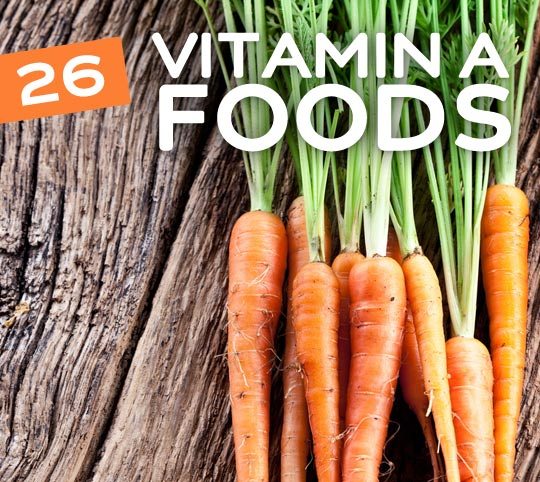Vitamin A is a vitamin and antioxidant that’s associated with healthy eyes. A diet rich in vitamin A can prevent nighttime blindness, eye inflammation, and dry eyes. It’s also used to treat several other health conditions. Vitamin A is measured in International Units (IU), and the average adult needs about 5000 IU per day.
[hr]
Carrots
When most people think of Vitamin A and eye health, they think of carrots. It’s true that eating plenty of carrots can improve your vision. One medium carrot accounts for over 200% of the average person’s vitamin A needs for the day. They’re also a great source of vitamins C, K, and B, plus magnesium and fiber.
Serving Size (1 medium), 10191 IU of Vitamin A (204% DV), 25 calories.
[hr]
Iceberg Lettuce
Typically, dark green leafy vegetables get all the glory when it comes to health foods. But the lighter green Iceberg lettuce variety is filled with essential vitamin A. Don’t be afraid to add some to your salad and sandwiches when you need an extra boost of vitamin A. One cup of shredded Iceberg lettuce contains only ten calories, and it brings a heap of other vitamins and minerals to your body.
Serving Size (1 cup shredded), 361 IU of Vitamin A (7% DV), 10 calories.
[hr]

Sweet Potatoes
Sweet potatoes were one of the main sources of food for early American settlers. Today, they’re still widely enjoyed for their delightful taste and rich nutrient contents. One medium sweet potato provides an incredible 438% of the average adult’s vitamin A needs for the day, all while adding only 103 calories to your diet.
Serving Size (1 medium), 21909 IU of Vitamin A (438% DV), 103 calories.
[hr]
Cod Liver Oil
Many people take cod liver oil supplements, as they’re a strong source of vitamins and minerals. Cod liver oil, which comes in both liquid and capsule form, contains vitamin D, vitamin A, and omega 3 fatty acids. A tablespoon of cod liver oil will allow you to meet and exceed the daily recommended intake of Vitamin A for the day.
Serving Size (1 tablespoon), 13502 IU of Vitamin A (270% DV), 122 calories.
[hr]
Green Bell Pepper
Add green bell pepper to your cooking throughout the day and see what a positive difference it makes, both in the flavor of your meals and in your health overall. A one-cup serving houses 11% of the daily recommended amount of vitamin A.
Serving Size (1 cup), 551 IU of Vitamin A (11% DV), 30 calories.
[hr]
Turkey Liver
After a delicious turkey dinner, many people make a habit of keeping the turkey giblets to use in a variety of ways. Turkey liver makes a great addition to gravy and stuffing, and it’s a surprising source of several vitamins and minerals. A 100-gram turkey liver is filled with an incredible 1507% of the recommended daily value of Vitamin A.
Serving Size (100 grams), 75333 IU of Vitamin A (1507% DV), 273 calories.
[hr]
Paprika
Paprika is commonly used in South American, Indian, and Spanish cuisine. But no matter where you’re from and what style of food you prefer, you can enjoy the many health benefits of this fiery red spice by incorporating it into your favorite meals. One tablespoon provides 71% of the recommended daily amount of vitamin A. It’s also an impressive source of vitamin C, potassium, and calcium.
Serving Size (1 tablespoon), 3560 IU of Vitamin A (71% DV), 19.5 calories.
[hr]

Mangoes
Mangoes are sweet, juicy fruits that have a place both in main dishes and on dessert plates. They also make a great addition to a healthy, balanced diet, thanks to the many nutrients and vitamins they supply. One cup of sliced mangoes provides 25% of the daily recommended amount of Vitamin A.
Serving Size (1 cup sliced), 1262 IU of Vitamin A (25% DV), 107 calories.
[hr]
Whole Milk
Many people favor whole milk over skim milk for its many nutrients and rich taste. A cup of whole milk is high in vitamins D and A, and it’s a good source of calcium, protein, and magnesium. It’s also highly inflammatory, though, so enjoy it in moderation or switch to nut milk instead.
Serving Size (1 cup), 249 IU of Vitamin A (5% DV), 146 calories.
[AdSense-A]
[hr]
Mustard Greens
Whether you eat your mustard greens raw or cooked, you’ll get plenty of flavor and nutrients out of these nutritional powerhouses. Just a cup of chopped mustard green provides 118% of the daily recommended value of vitamin A. Enjoy them often, because they’re also high in vitamin C, vitamin E, manganese, folate, fiber, protein, and calcium. It doesn’t get much better than that.
Serving Size (1 cup chopped), 5881 IU of Vitamin A (118% DV), 14.6 calories.
[hr]
Butternut Squash
The yellow-orange color of butternut squash is a sign that it’s high in beta carotene, which is converted to vitamin A in the body. A one-cup serving of butternut squash cubes contains almost 300% of the daily recommended value of vitamin A. It also contains enough vitamin C, potassium, and fiber to make a real difference in your body’s overall health.
Serving Size (1 cup cubes), 14883 IU of Vitamin A (298% DV), 63 calories.
[hr]
Dried Basil
A 100-gram serving of dried basil contains 188% of the daily recommended value of vitamin A. One hundred grams is a lot, but you don’t have to consume it all in the same meal, or even in the same day. When you think about how versatile dried basil is, you might find yourself adding it to nearly every meal you prepare. Sprinkle it over your foods throughout the week for an easy and effortless boost in vitamin A.
Serving Size (100 grams), 9376 IU of Vitamin A (188% DV), 251 calories.
[hr]

Kale
Kale is so much more than a common garnish: it’s a delicious and nutrient-rich vegetable that deserves a solid place in your diet. Kale can do wonders for your health, including helping you meet and exceed the amount of vitamin A that is recommended for the day. A one-cup serving of cooked kale contains 354% of what the average person needs.
Serving Size (1 cup), 17709IU of Vitamin A (354% DV), 36.4 calories.
[hr]
Cantaloupe
Cantaloupe is low in calories and fat, but high in vitamins and nutrients. It’s also a delicious addition to your day. Enjoy this succulent melon in a fruit salad, as a midday snack, or as an after-dinner dessert. One wedge, or about an eighth of an average-sized melon, provides you with 47% of the amount of vitamin A for the day.
Serving Size (1 wedge, or 1/8 medium melon), 2334 IU of Vitamin A (47% DV), 23.5 calories.
[hr]
Peas
Sweet green peas make a tasty side dish to many meals, and they’re a great supplement to a healthy diet. A 100-gram serving of peas provides 16% of the recommended amount of vitamin A, and with just a measly 84 calories. Peas are also high in vitamins C, K, and B.
Serving Size (100 grams), 801 IU of Vitamin A (16% DV), 84 calories.
[hr]
Turnip Greens
Getting more leafy greens into your diet is an excellent idea for several reasons: they’re low in calories, high in nutrients, and easy to prepare. Most dark green veggies can be consumed raw, but in the case of turnip greens, cooking or steaming them before eating them will allow more of certain vital nutrients to be absorbed by your body.
Serving Size (1 cup chopped), 10982 IU of Vitamin A (220% DV), 28.8 calories.
[hr]
Dried Apricots
Dried fruits make an easy and mess-free snack when you need a boost in nutrients, antioxidants, and energy. Dried apricots are a great option for a diet that’s rich in vitamin A. Just one cup of dried apricot halves contains 94% of the recommended value of vitamin A for the day.
Serving Size (1 cup halves), 4686 IU of Vitamin A (94% DV), 313 calories.
[hr]

Tomatoes
From a botanical standpoint, tomatoes are technically a fruit, though many people consider them to be a vegetable. However you classify them, you should be eating more of them, because they’re low in calories but high in several vitamins and minerals. Just one medium tomato provides you with 20% of your vitamin A needs for the day. They’re also an excellent source of vitamin C and lycopene.
Serving Size (1 medium), 1025 IU of Vitamin A (20% DV), 22 calories.
[hr]
Dried Marjoram
Many people use dried herbs for their unique flavors, but few realize the health benefits that come with consuming dried herbs. For vitamin A, dried marjoram is one of the best herbs you can find. A 100-gram serving houses 161% of the recommended daily vitamin A. One hundred grams is a lot, but you don’t have to eat it all at once! Instead, try incorporating it into different meals throughout the week to see what works, and you’ll enjoy all the health benefits along the way.
Serving Size (100 grams), 8067 IU of Vitamin A (161% DV), 271 calories.
[hr]
Spinach
Add more spinach to your diet each day, and you’ll enjoy a wonderful boost to many aspects of your health. In particular, make sure you’re getting enough vitamin A by enjoying a one-cup serving of spinach, which contains 56% of the daily recommended value. Spinach also provides your body with vitamin C, vitamin K, manganese, iron, and calcium.
Serving Size (1 cup), 2813IU of Vitamin A (56% DV), 6.9 calories.
[hr]
Peaches
The succulent peach is as rich in nutrients as it is in flavor. Peaches are high in Vitamin C, potassium, calcium, phosphorus, magnesium, and iron. In addition, if you need to get a quick boost of Vitamin A into your diet, one medium-sized peach provides about 10% of the amount the average person needs per day.
Serving Size (1 medium), 489 IU of Vitamin A (10% DV), 59 calories.
[hr]
Papaya
The tropical papaya fruit is rich in several vitamins, minerals, enzymes, and antioxidants. In particular, it’s a viable source of vitamin A. Just one small papaya provides 33% of the daily recommended value. The tasty papaya fruit is often eaten raw (minus the skin, seeds, and leaves), but it also makes a great ingredient in fruit salads and smoothies.
Serving Size (1 small), 1663 IU of Vitamin A (33% DV), 59 calories.
[hr]

Red Bell Peppers
Red peppers are as versatile as they are flavorful. Many people eat them plain or dressed with veggie dip, but you can also enjoy them in salads, scrambled eggs, and pasta dishes. Regardless of how you eat them, you’ll experience all the health benefits they provide to your body. Red bell peppers are rich in antioxidants including lycopene, vitamin C, and vitamin A.
Serving Size (1 medium), 3726 IU of Vitamin A (75% DV), 37 calories.
[hr]
Dandelion Greens
If you’re making a healthy salad or smoothie, consider throwing some dandelion greens into the mix. They’re high in calcium, rich in iodine, loaded with antioxidants, and low in calories. If vitamin A is a concern for your diet, just one cup of these greens provides over 100% of the daily recommended value.
Serving Size (1 cup), 5589 IU of Vitamin A (112% DV), 25 calories.
[hr]
Beef Liver
Your grandparents were right all along: liver is good for you. Liver is often touted as a great remedy for anemia, but it’s also a good source of vitamins C and A. A 100-gram serving of beef liver supplies well over 300% of your necessary vitamin A intake for the day.
Serving Size (100 grams), 16898 IU of Vitamin A (338% DV), 135 calories.
[hr]
Fortified Oatmeal
Many grains and dairy products are fortified with essential vitamins that people typically don’t get enough of in their diets. These include vitamins D and A. In the case of vitamin A, many brands of fortified oatmeal contain up to 20% of the daily value per one-packet serving. Be sure to check the nutrition labels the next time you’re shopping for your favorite kind of oatmeal.
Serving Size (1 packet cooked), 1000 IU of Vitamin A (20% DV), 105 calories.
[hr]
Vitamin A is an essential part of a healthy diet. It’s especially important in the proper development, functioning, and maintenance of the eyes, skin, and immune system. Fortunately, this important vitamin and antioxidant can be found in abundance in many fruits, vegetables, meat, fish, and dairy sources that you probably already include in your diet.




